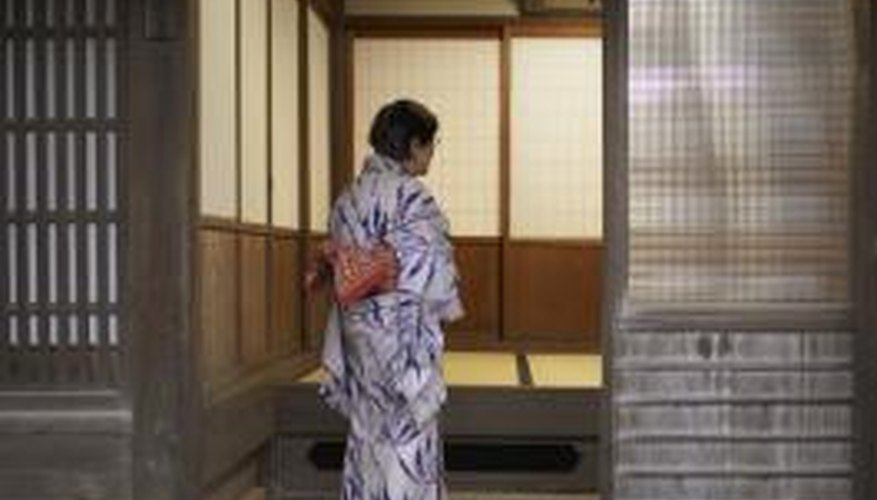Japanese clothes and fashions ranged from traditional garb to mandated uniforms during the 1940s. Historically, Japanese clothes have maintained loose fitting, lightweight fabric designs in both men's and women's clothes. The designs went hand in hand with the physical and spiritual traditions of t'ai chius martial arts.
Kimonos
Kimonos are silk, loosefitting robes that extend back through Japanese history for thousands of years. During the 1940s, kimonos were often plain in design or included embroidered patterns. Patterns resembled floral arrangements or a layering of solid colours. Kimonos draped around the shoulders. Sleeves extended down to the wrists, and the lower portion of the garment stretched down far enough to cover the ankles. Kimonos during the 1940s were worn by both men and women. Kimonos were also used as sources of propaganda during the war effort -- they were manufactured with images of war planes and heroic fighters.
- Kimonos are silk, loosefitting robes that extend back through Japanese history for thousands of years.
- Kimonos during the 1940s were worn by both men and women.
Sashes
Sashes were also worn by both Japanese women and men in the 1940s. Sashes, or obis, pulled kimonos close around one's waist and were decorative additions to female dresses. Sashes came in all sorts of colours and textures and were often manufactured from silk. Alternate colours and patterns indicated social distinctions as well, from marital status to age or socio-economic position.
- Sashes were also worn by both Japanese women and men in the 1940s.
- Sashes, or obis, pulled kimonos close around one's waist and were decorative additions to female dresses.
Inclement Weather Clothes
Japanese fashion included all forms of garments for working outside during inclement weather. Both men and women -- of all socio-economic statuses -- wore inexpensive hats and jackets made out of straw during rainy days. Straw-based clothes were woven together with weatherproof precision. Tightly woven straw proved a great benefit for repelling droplets of rain. Straw thong sandals were also worn on the feet of men and women to keep the soles of feet dry and protected from sloppy ground conditions.
- Japanese fashion included all forms of garments for working outside during inclement weather.
- Straw thong sandals were also worn on the feet of men and women to keep the soles of feet dry and protected from sloppy ground conditions.
Mandated Uniforms
Following the attack on Pearl Harbor and Japan's merge with the military forces of Germany and Italy, many Japanese Americans were forced to live and work in U.S.-based concentration camps during the 1940s. Workers were ordered to wear cotton trousers and long-sleeved shirts for work in fields and on roads. Shirts included two breast pockets, and workers were also provided with short-brimmed hats to keep sun and sweat out of the eyes during long, daytime working hours.
